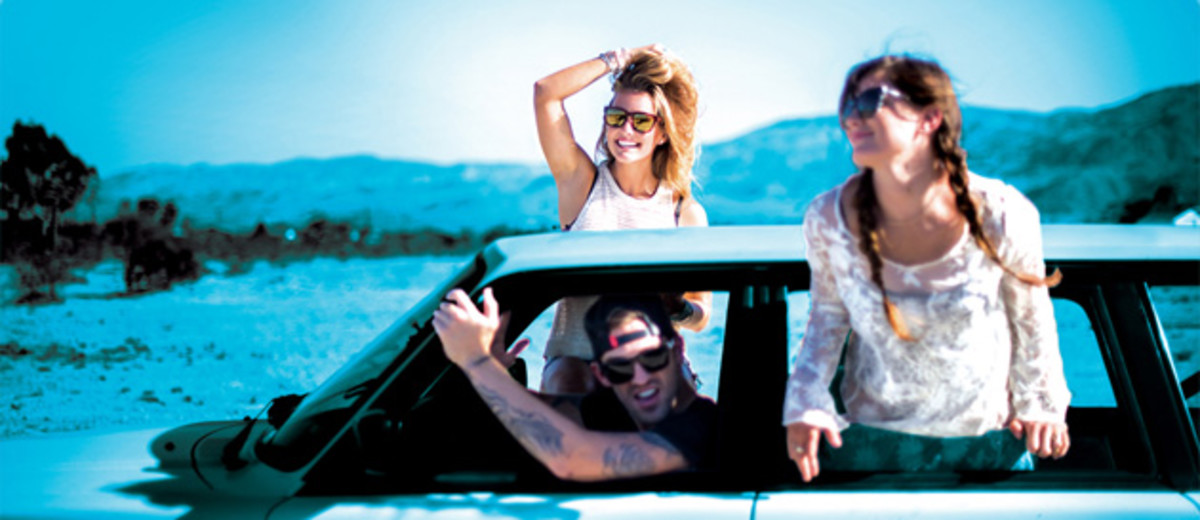Making your eyes—and brain—happy with long-wave blue light lenses

Blue light equals a happy brain, according to Spy Optic. That's the reason the eyewear company created the Happy Lens for use in everything from fashion to high-performance sunglasses and goggles for action sports.
Created in 1994, and now the nation’s largest independent eyewear brand, Spy Optic created the Happy Lens line of eyewear to block the sun’s harmful UV rays and short-wave blue light. But the new technology embraces all things long-wave blue light.
Why blue light? For the happiness, of course.
A surplus of studies show that long-wave blue light promotes the production of serotonin in the brain, which has a positive bearing on the body’s circadian rhythm and helps humans feel good. We see the blue-light technology everywhere from light bulbs trying to treat seasonal affective disorder to airplanes where airlines look to calm the nerves of anxious passengers.

provides, also increasing alertness, Spy wanted to embrace all things blue light.
To get there, though, the California-based company needed to adapt their technology. “We had to specially tweak the pigments to create the right transmission curve for the Happy Lens,” Juliette Koh, Spy product director, tells Edge. “The recipe had to be exact to maximize the long-wave blue light transmittance while getting the correct coloring.”
Making materials matter: Patagonia launches Earth-loving line
That coloring proves important across their line of 20 different lenses.
Louie Vito, a professional snowboarder, U.S. Olympian and Winter X Games gold medalist, tells Edge he uses a variety of those fresh options, mixing up the frames and lenses to have different colors based on his needs—whether training off the mountain or snowboarding on Oregon’s Mount Hood or Colorado’s Breckenridge.
Right now Vito uses the new Bravo goggle, mixing in Happy Lens tints, his favorite are the ones with the “blueish mirror” because of the definition it provides on the snow. “The conditions are always changing in the mountains and you never know how it is going to be 10 minutes from now,” he says. “I like the blue right now that I have.”
The Happy Lens selection remains relatively new to Vito, but he already likes what he sees. He participated in a photo shoot recently at Whistler in British Columbia, Canada, using the Happy Lens. “I didn’t know what I was going to get,” he says. “It started sunny and then the clouds rolled in and they were amazing.”
Liquid protection helps with CCM’s new hockey helmet design
wall and bright on the other and you are constantly adjusting and focusing. You are about to go chuck yourself 20 feet in the air and the last thing you want is to worry if you can see or not.”
Definition proves the most important aspect in a lens for Vito. During the halfpipe, the gutter and flat bottom gets so rutted out, it can quickly bump you off your edge. “There are a lot of things that can happen,” he says, “just by not being able to see.”
With the spherical arc Happy Lens, Vito says he gets vivid color without the distortion. Anytime he has used flat lenses, his curved eye tires.
“The closer it can be to your normal vision, the better,” he says. “And then add in what the Happy Lens does, it makes everything better. If you have a good lens, staring at white snow without a cloud in the sky 11,000 feet up where the sun is so crazy strong is a great feeling. Your eyes aren’t burning or hurt.”
No, not burning or hurt: Eyes stay happy. Just like your brain, after soaking in all that long-wave blue light.
Tim Newcomb covers stadiums, design and gear for Sports Illustrated. Follow him on Twitter at @tdnewcomb.
